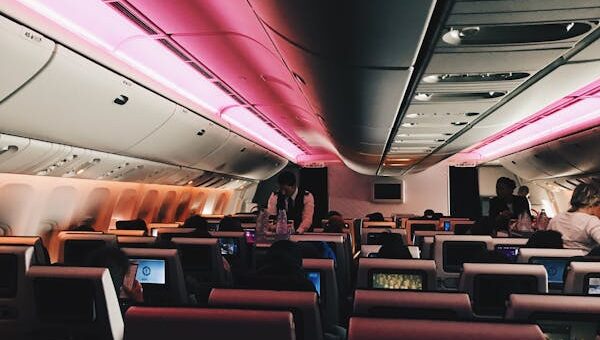
Introduction
Commercial aircraft interiors have evolved dramatically over the years, driven by advancements in technology, changing passenger expectations, and increasing airline competition. Modern cabins are designed not only to maximize comfort but also to improve efficiency, reduce environmental impact, and enhance the overall flying experience. This article explores the most notable innovations in commercial aircraft interiors, focusing on seating design, cabin ambiance, in-flight entertainment, and sustainability. By understanding these developments, passengers and industry professionals alike can appreciate how aviation is continuously improving the way we fly.
1. Evolution of Aircraft Interiors: From Basic to Sophisticated
1.1 Early Aircraft Cabin Designs
In the early days of commercial aviation, aircraft cabins were simple and utilitarian. Seats were basic, space was limited, and in-flight amenities were minimal. The primary focus was on functionality rather than comfort.
-
Narrow seats with minimal padding.
-
Limited legroom and cabin space.
-
Few onboard services and entertainment options.
Over time, as air travel became more accessible and competitive, airlines sought to differentiate their offerings by enhancing cabin comfort and aesthetics.
1.2 The Shift to Passenger-Centric Design
Starting in the late 20th century, the airline industry began adopting a passenger-centric approach, placing greater emphasis on ergonomics, aesthetics, and convenience.
-
Introduction of reclining seats and adjustable headrests.
-
Improved lighting and noise insulation.
-
Greater attention to cabin layout for better space utilization.
These innovations laid the groundwork for today’s high-tech, passenger-friendly interiors.
2. Advanced Seating Technologies
2.1 Ergonomic and Space-Saving Seats
Innovations in seat design focus on maximizing comfort while optimizing cabin space. New materials and engineering techniques allow seats to be lighter and thinner without sacrificing support.
-
Slimline seats use lightweight materials and slim frames.
-
Ergonomically contoured cushions improve posture.
-
Adjustable lumbar support and customizable settings.
Airlines can thus increase passenger capacity while enhancing comfort, benefiting both operators and travelers.
2.2 Premium Seating and Customization
First-class and business-class cabins have seen groundbreaking innovations, offering luxurious comfort with advanced features.
-
Fully lie-flat seats with massage functions.
-
Privacy pods with sliding doors and personal lighting.
-
Customizable climate controls and in-seat entertainment.
These features create a personalized experience that appeals to high-end travelers and business customers.
3. Cabin Ambiance and Lighting Innovations
3.1 LED Mood Lighting Systems
Modern aircraft use sophisticated LED lighting to create ambient environments that enhance passenger wellbeing and reduce jet lag.
-
Dynamic lighting adjusts color and intensity throughout the flight.
-
Mimics natural daylight cycles to regulate circadian rhythms.
-
Creates soothing atmospheres during boarding and nighttime.
LED systems are energy-efficient and customizable, providing airlines with branding opportunities through color schemes.
3.2 Noise Reduction and Air Quality Improvements
Comfort in the cabin extends beyond visual aesthetics. Recent innovations also address noise levels and air quality.
-
Advanced soundproofing materials reduce engine and airflow noise.
-
High-efficiency particulate air (HEPA) filters improve cabin air purity.
-
Enhanced ventilation systems maintain optimal humidity levels.
Together, these improvements create a quieter, healthier environment conducive to rest and relaxation.
4. In-Flight Entertainment and Connectivity
4.1 High-Definition Screens and Interactive Systems
In-flight entertainment (IFE) has transformed from overhead screens to personalized, interactive systems.
-
Large touchscreens with high-definition resolution.
-
On-demand movies, TV shows, games, and music libraries.
-
Integration with passengers’ personal devices via Wi-Fi.
These features keep travelers engaged and comfortable during long flights.
4.2 Internet Connectivity and Digital Services
Increasingly, airlines provide reliable internet access onboard, enabling passengers to stay connected.
-
Satellite-based Wi-Fi offers browsing, messaging, and streaming.
-
Mobile apps allow for food ordering, flight tracking, and service requests.
-
Enhances the passenger experience and opens revenue streams for airlines.
Connectivity is becoming a must-have feature in modern aircraft cabins.
5. Sustainable and Eco-Friendly Interior Innovations
5.1 Use of Sustainable Materials
Sustainability has become a priority in aircraft interior design, with airlines incorporating eco-friendly materials.
-
Recycled fabrics and plastics for seat covers and carpets.
-
Lightweight composite materials reduce overall aircraft weight.
-
Non-toxic, flame-retardant materials for safety and environmental health.
These choices help reduce the carbon footprint and appeal to environmentally conscious passengers.
5.2 Waste Reduction and Efficient Cabin Systems
New systems aim to minimize waste and resource consumption onboard.
-
Water-saving lavatory fixtures.
-
Waste recycling programs and biodegradable packaging.
-
Energy-efficient lighting and climate control.
Sustainable interiors support broader industry goals for greener aviation.
Conclusion
Innovations in commercial aircraft interiors have revolutionized the passenger experience by combining comfort, technology, and sustainability. From ergonomic seating and immersive lighting to advanced entertainment systems and eco-friendly materials, modern aircraft cabins are designed to meet the evolving needs of today’s travelers. As airlines continue to innovate, what interior features do you value most during a flight? Share your thoughts and preferences—your insights could inspire the next wave of cabin design innovations.